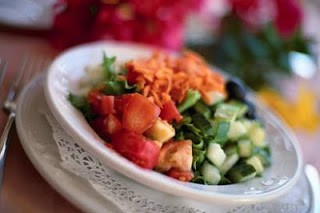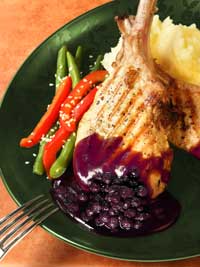Eat Fruits & Veggies When You Need Them Most
5 Ways to Increase Your Daily Cups When It’s Cold Outside

When the mid-winter freeze is in full swing, it’s easy to wax nostalgic about the fresh fruits and vegetables of summer. Holding onto warm-weather memories may be one reason we tend to eat fewer fruits and veggies in the winter. Ironically, it’s the time of year when we need them more than ever: healthy eating and optimum servings can boost our immune system and our mood at a time when winter blues can seem to be as much of an epidemic as the flu.
It may be cold outside, but that’s no excuse to wait for summer to fill your plate with disease-preventing, nutrient-rich foods. To keep your eye on your health this season, remember that the USDA recommends 2 cups of fruit and 3 cups of vegetables, on average, for a total of 5 cups every day. Make the extra effort to pile fruits and veggies on your plate when you need them most – when the snow flies, the mercury drops, and shorts sleeves and sandals are just a memory.
Increase Your Cups This Winter – 5 Easy Ways
 1. Bake Your Fruits. Winter is the perfect time to indulge in delicious baked fruits and get your recommended cups warm from the oven. Not available fresh? No problem – find fruit in the frozen aisle. Frozen is perfect for baking and has all the taste and nutrition of fresh. Homemade desserts are also an ideal way to avoid the processed treats that swarm the store shelves. Warm Wild Blueberry Pie delivers a nutritious punch in a classic package. Or, opt for the fresh-from-the-oven comfort of this Bread Pudding smothered with wild blueberries for taste and disease prevention in one helping. PBS’s Fresh Taste offers up these phyto-rich baked apples to warm your cockles – an easy way to enjoy a cup of fruit. (Just one more to go!)
1. Bake Your Fruits. Winter is the perfect time to indulge in delicious baked fruits and get your recommended cups warm from the oven. Not available fresh? No problem – find fruit in the frozen aisle. Frozen is perfect for baking and has all the taste and nutrition of fresh. Homemade desserts are also an ideal way to avoid the processed treats that swarm the store shelves. Warm Wild Blueberry Pie delivers a nutritious punch in a classic package. Or, opt for the fresh-from-the-oven comfort of this Bread Pudding smothered with wild blueberries for taste and disease prevention in one helping. PBS’s Fresh Taste offers up these phyto-rich baked apples to warm your cockles – an easy way to enjoy a cup of fruit. (Just one more to go!)
 2. Enjoy Sauces. Love a piping hot tomato sauce in the wintertime but worried about what the impact of eating like Mario Batali could have on your health? Don’t despair. Tomatoes are full of lycopene, known to possess antioxidant properties, and cooked tomatoes are the best-case scenario – cooking actually boosts their nutritional value. Not to mention, their pairing with pasta is the ultimate comfort food, and adding kale or other leafy greens can easily add bulk as well as nutrition.
2. Enjoy Sauces. Love a piping hot tomato sauce in the wintertime but worried about what the impact of eating like Mario Batali could have on your health? Don’t despair. Tomatoes are full of lycopene, known to possess antioxidant properties, and cooked tomatoes are the best-case scenario – cooking actually boosts their nutritional value. Not to mention, their pairing with pasta is the ultimate comfort food, and adding kale or other leafy greens can easily add bulk as well as nutrition.
Make your sauce at home for the healthiest option – it’s easy. According to Marcella Hazan, creativity is overrated when it comes to sauce – this classic recipe will do just fine. Or, pull back on the pasta by making use of your sauce with seafood and consider the omega-3s you’ll get an added bonus.
3. Make Soup. Soups are an excellent winter option: they are veggie-packed and offer homemade warmth for winter nights. Soup can also provide meal planning relief because of its versatility — assembly can be a cinch with just a few kitchen staples.
This Carrot Parsnip Soup takes advantage of winter veggies, as does this hearty Winter Vegetable Soup if a substantial meal is in order. Need more slurp-worthy ideas? These Best Soup Recipes from Cooking Light keep calories minimized while maxing-out taste.

4. Roast Your Vegetables. Root cellars have gained popularity for food lovers as a way to store winter vegetables like potatoes, onions, parsnips, and squash when they are inexpensive and available. Even if you aren’t using designated storage, roasted root veggies are a warm winter alternative to salads. Try these Honey Roasted Root Vegetables or a Roasted Root Vegetable Quesadilla. Or, discover the wonders of roasting or baking less common vegetables this season like kohlrabi, leeks or the sweetly delicious and seasonal rutabaga.
 5. Bathe Comfort Food in Berries (& Other Healthy F&Vs). Steven Pratt, author of SuperfoodsRx, suggests we “bathe our meals in berries” for optimal nutritional benefit and disease prevention. Pairing comfort foods with a helping of high nutrition certainly helps keep the health quotient of our meals in check. Douse a piece of fish with wild blueberry sauce, pair salads with berries, or cover desserts and breakfasts with them – using fresh frozen wild blueberries is a convenient way to make them available by the cup at every meal.
5. Bathe Comfort Food in Berries (& Other Healthy F&Vs). Steven Pratt, author of SuperfoodsRx, suggests we “bathe our meals in berries” for optimal nutritional benefit and disease prevention. Pairing comfort foods with a helping of high nutrition certainly helps keep the health quotient of our meals in check. Douse a piece of fish with wild blueberry sauce, pair salads with berries, or cover desserts and breakfasts with them – using fresh frozen wild blueberries is a convenient way to make them available by the cup at every meal.
Case in point? These Wild Blueberry Rhubarb Pork Chops, a marriage of comfort and nutrient richness. Or, go ahead and pair the classic comfort of a Ham Sandwich with tasty, antioxidant-rich berries for a pleasing way to rack up your daily cups. You can also combine beloved winter comfort foods like steak and potatoes with nutrition-rich greens like this creamed spinach which keeps the calories moderate and your daily servings in the black.
Get your cups this winter! Know the facts about the USDA Dietary Guidelines and fill half your plate with fruits and veggies!

